Menus
- 218 hp put to the test
- Is the Kawasaki Ninja H2 even suitable for everyday use?
- Yamaha YZF-R1 as reference in the top test
- Kawasaki Ninja H2 with a stoppie tendency
- Drive like there is no traction control
- Assistance systems from the ZX-10R
- Conclusion
- Technical data Ninja H2
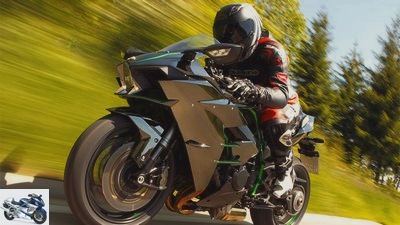
Bilski
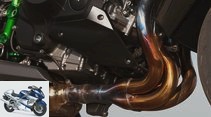
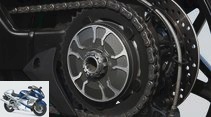
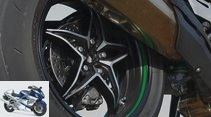
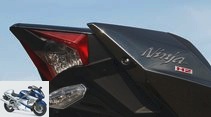
26th photos
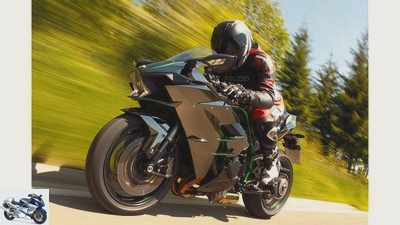
Bilski
1/26
With 218 hp, the H2 is the most powerful bike on the MOTORRAD test bench to date.
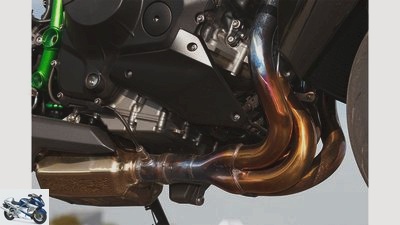
Bilski
2/26
The polished stainless steel elbows form a beautiful metal sculpture.
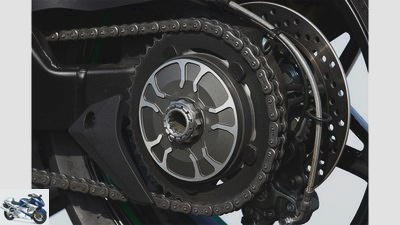
Bilski
3/26
Technically, a single-sided swing arm offers hardly any advantages. But …

Bilski
4/26
… it signals the pursuit of noble mechanical engineering.
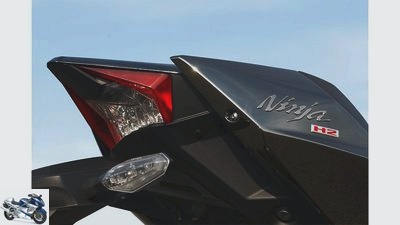
Bilski
5/26
Kawasaki Ninja H2.
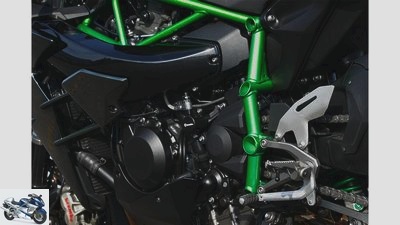
Bilski
6/26
The minimalist tubular frame is neatly welded, the footrest system of exemplary simplicity and quality.
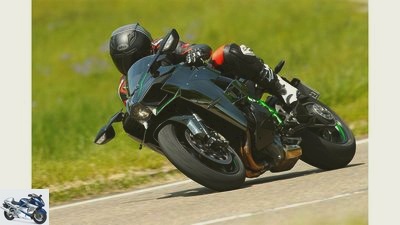
Bilski
7/26
Kawasaki Ninja H2.

Bilski
8/26
This photo shows the impeller used to compress the introduced air.
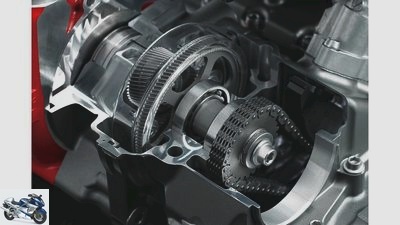
Bilski
9/26
Here you can see the drive side of the compressor with chain drive and planetary gear.
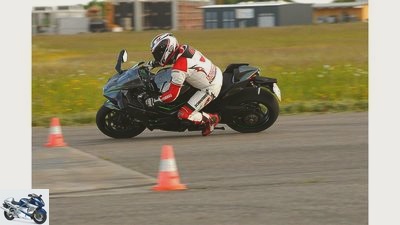
Bilski
10/26
Pulling on the rear wheel reduces the H2’s tendency to understeer. In slow corners like the top test slalom, however, it is clearly evident.
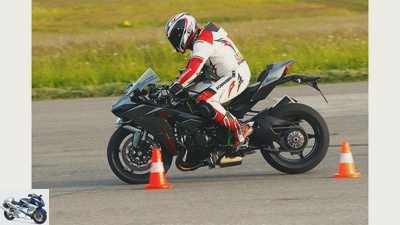
Bilski
11/26
In the event of emergency braking, the rear wheel sometimes lifts off quickly and far. Then the brake must be released briefly, otherwise there is a risk of rollover.

Bilski
12/26
Current competitors of the Ninja H2.

Bilski
13/26
The compressor housing: Because of the charging, the engine was made more solid than the ZX-10R.

Bilski
14/26
An electronically controlled steering damper from Ohlins always had the steering under control.

Bilski
15/26
However, she is not a super athlete.
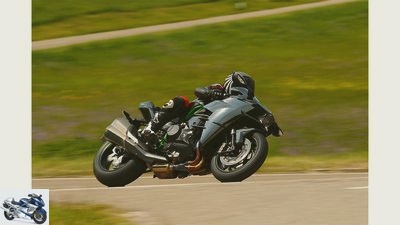
Bilski
16/26
Your large wheelbase and long caster plus …
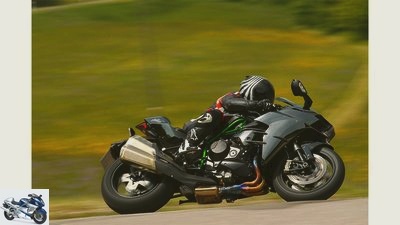
Bilski
17/26
… 30 to 40 kg more weight than current super sports cars impairs handiness and steering precision.
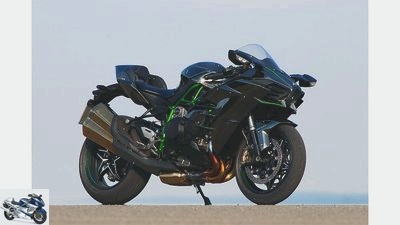
Bilski
18/26
Kawasaki Ninja H2.
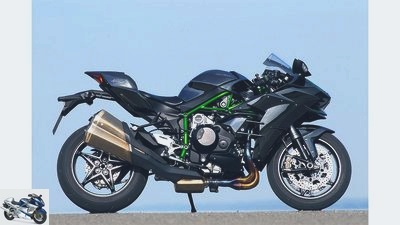
Bilski
19/26
Kawasaki Ninja H2.
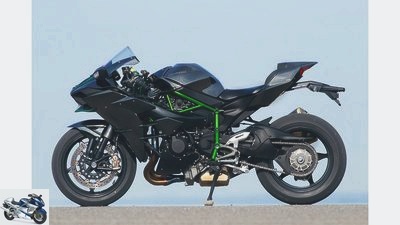
Bilski
20/26
Kawasaki Ninja H2.
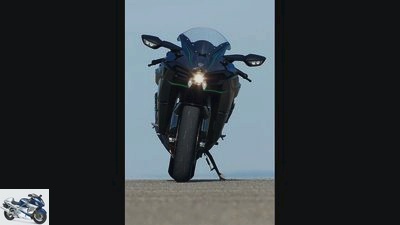
Bilski
21/26
Kawasaki Ninja H2.
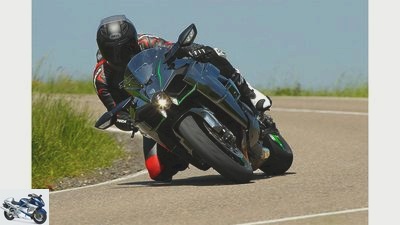
Bilski
22/26
Kawasaki Ninja H2.
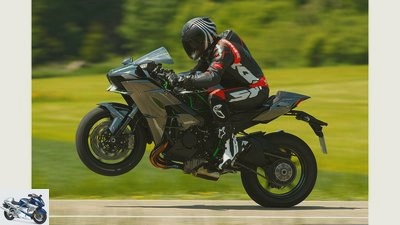
Bilski
23/26
The KTRC traction control also includes a wheelie control,
but whose work is not always transparent.
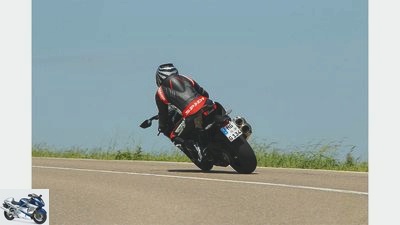
Bilski
24/26
Kawasaki Ninja H2.
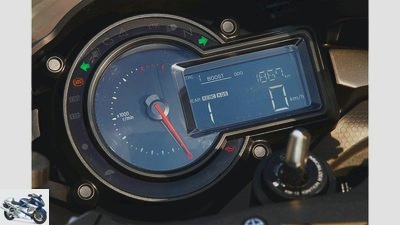
Bilski
25/26
Not much happens in the cockpit when the car is stationary, the show only begins when the engine is running.

MOTORCYCLE
26/26
As if drawn with a ruler – this is how the optimal performance curve is described in textbooks and in popular parlance. The curves of the H2 come closer to this ideal than any other motorcycle before. The short gear ratio of the H2, both in total and the lower three gears, increases the feeling of brute engine power, but is a disadvantage in terms of fuel consumption and tire wear.
Kawasaki Ninja H2 in the top test
218 hp put to the test
The Kawasaki Ninja H2 has a 1000cc four-cylinder with supercharger, and this hurricane inside creates hurricanes of acceleration and speed on the outside. With 218 hp, the H2 is the most powerful series machine ever measured by MOTORRAD.
"Please take care of the rear tire, you know what’s to come." Even before the start of the photo ride with the compressor Kawasaki Ninja H2 are all concerned about the further progress of the test procedure. The concern was not unfounded, the lively morning rush hour on the short stretch of the motorway to the photo area allowed only a few advances into the Reich beyond 200 km / h, but the driving forces had already rolled thin rubber sausages out of the tread over the entire circumference of the rear tire.
Buy complete article
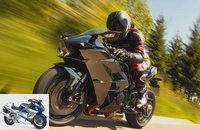
Kawasaki Ninja H2 in the top test
218 hp put to the test
Kawasaki Ninja H2. There is no phase of weakness, no behavior. What looks like it at just over 7000 rpm takes place at a height of 118 Nm and cannot be felt at all in practice. The summit is a 1000-rev wide plateau, the height of which is between 215 and 218 hp. In unwanted but unavoidable blasphemy, fragments of prayer such as “the power and the glory” come to mind while driving.
Is the Kawasaki Ninja H2 even suitable for everyday use?
The fact that this force does not have the ultimate effect on the acceleration values is paradoxically due to the relatively short gear ratio of the Kawasaki Ninja H2. This applies to the overall ratio and especially to the first three gears. While the first gear of the current 1000 super sports car goes up to over 140 km / h, the H2 engine turns into the limiter at 125 km / h. The second gear goes up to 157, the third up to 195, which is why one more gearshift is necessary than is usual in this performance class before the 200 km / h threshold is reached. Nevertheless: From zero to 200 in seven seconds is a decisive announcement, and the positive downside of the short translation is shown in the truly sensational torque values.
Apart from the high manual force required to operate the clutch, it is very helpful to its drivers in mundane rush hour traffic in the city and in the country. The direct mechanical coupling of the crankshaft and charger ensures the aforementioned power at low speeds, and the linear build-up of power prevents the engine from suddenly cracking. In addition, the four-cylinder runs mechanically very smoothly and cultivated; Kawasaki probably put together the engine parts for the small series with special care. The two balancer shafts in front of and behind the cylinder block make a major contribution to the smooth running.
Yamaha YZF-R1 as reference in the top test
Modestly moved, the Kawasaki Ninja H2 even holds back when it comes to fuel consumption. The significantly higher consumption at a constant 130 km / h, however, indicates what happens when the compressor is revved up more frequently. If you succumb to fascination and drive with high performance, you can easily burn well over ten liters per 100 kilometers. This information is here as an anachronism because it was only determined at the end of the test. Because after photo, measurement and consumption measurement drives as well as the test bench runs, the rear tire was already marked by the strain. Even with civilian driving, the Kawasaki Ninja H2 eats it up. The exhortations grew in urgency. “You shouldn‘t go on the test lap and the top test course with two edges in the rear tire.” Yes, yes.
The Yamaha YZF-R1 served as a reference for the test round. It was very helpful because it quickly made it clear what the Kawasaki Ninja H2 is not: a super athlete. That was to be assumed because it has a long wheelbase and a comparatively long caster, and it also weighs between 30 and 40 kilograms more than the current sports motorcycles. In addition, 129 of the total of 239 kilograms weigh on the front wheel. This unusually high front wheel load contributes to the praiseworthy high-speed stability of the H2, as does the horizontal fairing surfaces placed at an angle in the airstream, but it impairs handiness and steering precision. Forced sporty driving on routes with many slow corners or in the top test course is not your thing. It wants to be brought into an inclined position with a steady hand and more time than the nimble R1, and pushes in long, slow-moving arcs over the front wheel.
And regardless of whether the far forward protruding fairing dome of the Kawasaki Ninja H2 is “only” noticeable psychologically or actually through the higher weight on the longer lever arm in front of the steering axle, it increases the feeling of understeer. The sometimes harsh load changes also make driving on winding roads difficult.
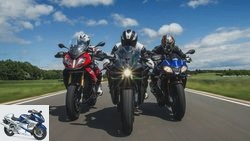
Naked bike
Aprilia Tuono V4 1100 RR, Kawasaki Ninja H2 and BMW S 1000 XR in the comparison test
A colorful trio
read more
All tests and articles about the Kawasaki Ninja H2
All tests and articles about the Kawasaki H2R
Kawasaki Ninja H2 with a stoppie tendency
The dynamics of constant load changes reveal another characteristic of the compressor motor that is otherwise not noticeable: Sometimes the power starts after a few seconds of pushing in the braking zone and in the corner entry with a tiny delay, but then with power. Then you need to react quickly, but it should not be hectic. “In the beginning I made as many mistakes here as with hardly any other motorcycle, the H2 demands all concentration”, stated a visibly exhausted top tester Georg Jelicic after numerous rounds in the fast and slow slalom. The true pleasure in curves with the Kawasaki Ninja H2 is provided by combinations drawn in generous swings.
Braking at the limit, as is usual with deceleration measurements, hardly requires less concentration despite ABS. A series of measurements resulted in a highly respectable average deceleration of 9.6 m / s² as the best value achieved several times. But that’s only half the story, because the best attempts were also opposed to two extremely bad ones, in which the brake had to be released because the rear wheel had to climb too quickly and too high. “The KIBS does not prevent the rear wheel from lifting”, says the driver’s manual succinctly. KIBS means “Kawasaki Intelligent Antilock Brake System”. But a little more intelligence in recognizing stoppies wouldn’t do any harm, especially since the stoppie tendency of the Kawasaki Ninja H2 seems to be increasing with its red hot brake system. Incidentally, this sentence conceals praise for the Brembo hardware of the H2 brake system. It even withstands numerous measurements in quick succession from 100 km / h to a standstill, whereby the pressure point only moves a little and the excellent controllability is only slightly worse. That means something, because braking to a standstill particularly heats up the discs and tongs due to the lack of airflow and the Kawasaki Ninja H2 is also a pretty heavy chunk.
Drive like there is no traction control
Like the KIBS, the KTRC (Kawasaki Traction Control) is not a fully comprehensive insurance either. While trying to improve the mediocre times in the slow slalom, top tester Georg had to catch two vehement slides himself despite traction control. This behavior required systematic tests – “the rear tire hopefully still has a little rubber on the tread” – which tended to produce the following results: In the standard setting of the traction control, the level one that intervenes least and that was activated in slalom, Deliberately brute acceleration in an inclined position can actually lead to violent slides, possibly even to falls with the Kawasaki Ninja H2. However, if you drive as if the traction control were not available, i.e. carefully approaching the limit when accelerating in an inclined position, you will see the KTRC indicator light in the cockpit light up every now and then, you will also feel how the power is gently reduced, but you will not experience the breakout Rear wheel. Level two, on the other hand, regulates very defensively, you have the feeling of being slowed down excessively.
The three levels of the KTRC can each be subdivided into “normal” and “plus” for more extensive and “minus” for minor interventions, and ultimately the “two minus” or “one plus” settings were recommended as the best compromises. The rain mode of the Kawasaki Ninja H2 proved to be unsuitable – even in the rain. This is less due to the greatly minimized peak power, estimated at around 80 hp, but to the overly careful intervention of the traction control. Even at the slightest lean angle, it only releases so little power that it is not enough to overtake a small car out of a curve on a pass-like road.
Assistance systems from the ZX-10R
In general, on the Kawasaki Ninja H2, you need to be extremely attentive but relaxed at all speeds. She wants to be set on the right curve path without jagged steering maneuvers, her behavior when braking sharply or accelerating vehemently needs to be watched carefully, no, especially carefully. Rabid driving maneuvers that quickly reach the limit will not be able to be captured by your driver assistance systems. They come from the ZX-10R, have been adapted for the H2, but have obvious difficulties in calculating the performance and the power consumption of the engine and brakes.
And now? Photos taken, test bench and measurement drives completed, test laps and courses completed, traction control checked – now we’re finally on the highway. Unfortunately that wasn’t possible at four in the afternoon. This time, the rush hour traffic after work hung on the Kawasaki Ninja H2 like a lead ball. Nobody could understand the dynamism it unfolded in a few hundred meters of free left lane and how ridiculous it looks from the H2 driver’s control room when an ambitious citizen needs three kilometers in his cage to overtake another at 171 km / h.
Nobody needs to understand that, so the author and occasional H2 driver drove home slightly frustrated, parked the motorcycle and sat in a garden chair next to it. In the slow pace of leisure, he enjoyed the dignified processing of the exclusive Kawasaki Ninja H2, which cooled down with a slight heat shimmer and a quiet crackling. The remaining tread depth of the rear tire was 1.9 millimeters in the middle after almost 1400 kilometers. And he made up his mind to get up very early next Sunday.
Conclusion




26th photos
Pictures: Kawasaki Ninja H2 in the top test
To home page
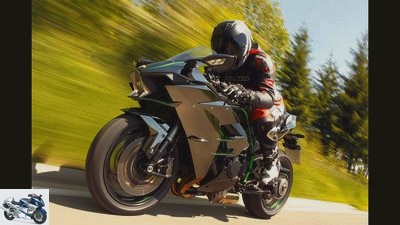
Bilski

Bilski

Bilski

Bilski
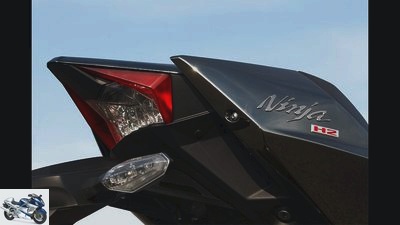
Bilski
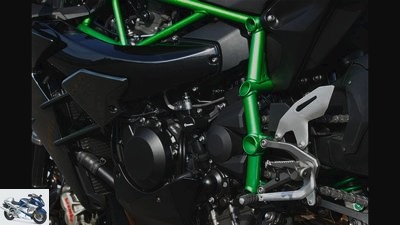
Bilski
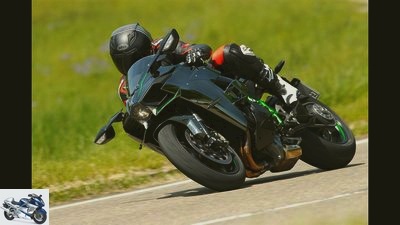
Bilski
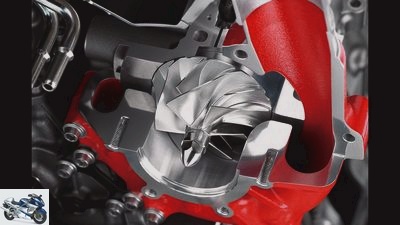
Bilski
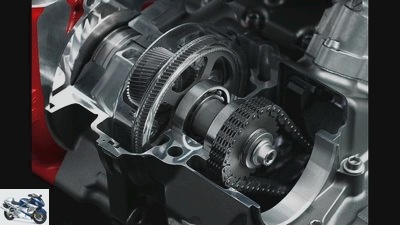
Bilski
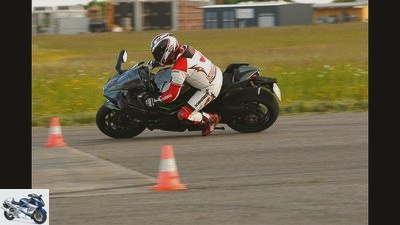
Bilski
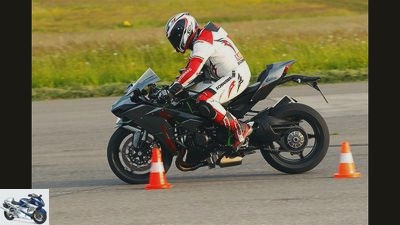
Bilski
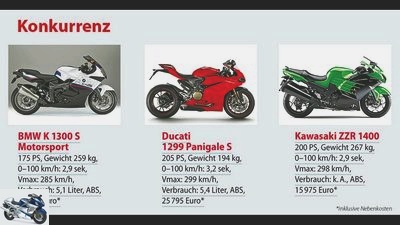
Bilski
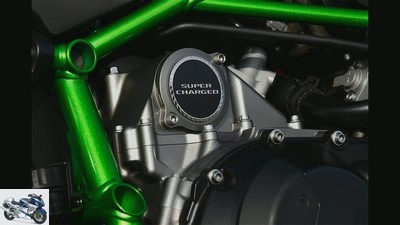
Bilski
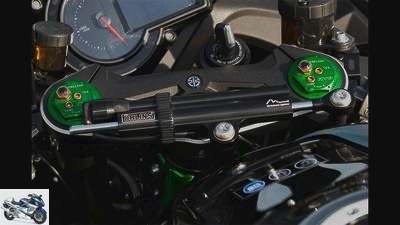
Bilski
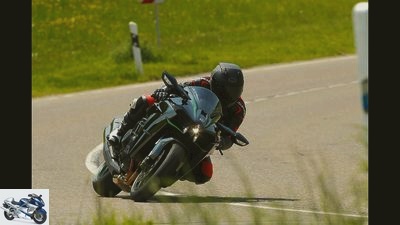
Bilski
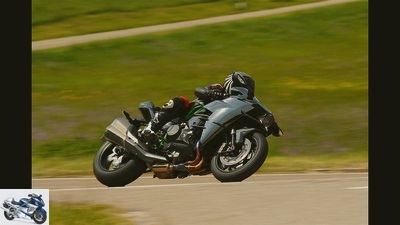
Bilski
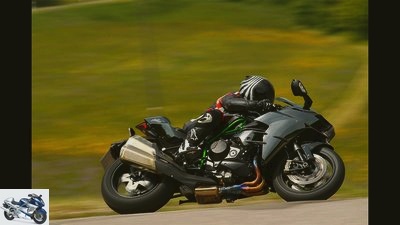
Bilski
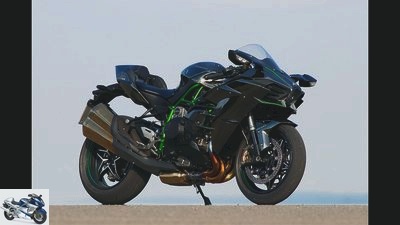
Bilski
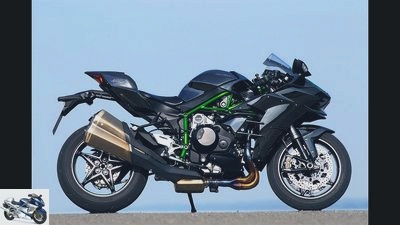
Bilski
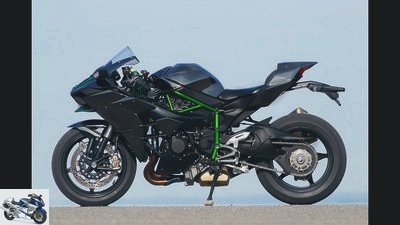
Bilski
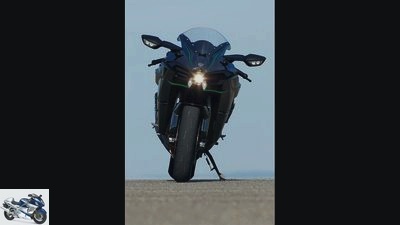
Bilski

Bilski
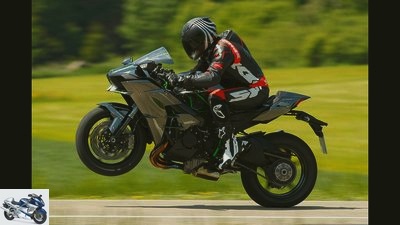
Bilski
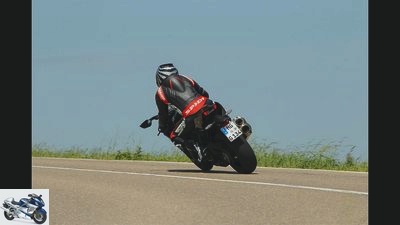
Bilski

Bilski
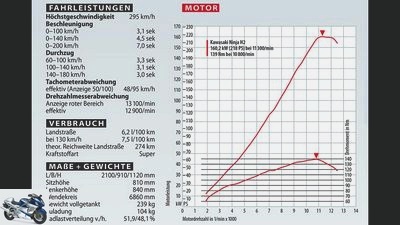
MOTORCYCLE
Charging by compressor
Bilski
Impeller to compress the introduced air.
Unlike the turbocharger of the Kawasaki Z 750 Turbo, in which the compressor wheel is driven by the exhaust gas flow and therefore always delayed, the compressor of the Kawasaki Ninja H2 is mechanically coupled to the crankshaft. The compressor shaft is set in rotation from there by a toothed chain, behind which a powerful transmission with three planetary gears on the axis of the impeller ensures its extremely high speeds. The impeller reaches up to 130,000 rpm, which is why it has to be manufactured and stored with particularly high precision from extremely high-quality materials. In this context, the Kawasaki engineers proudly refer to their experience with the production of turbines, which is also part of the Kawasaki Heavy Industries technology group. The pride is justified, a pure motorcycle manufacturer would have to buy the technological competence from the outside.
Thanks to the mechanical drive, the compressor ensures a noticeable increase in performance even at low engine speeds. As the performance curve shows, the engine of the Kawasaki Ninja H2 has no so-called turbo lag. The top test, however, showed that the boost pressure in the intake system, which should actually be called the injection system here, builds up with a slight delay. This becomes particularly clear with frequent, rapid load changes on winding roads. Naturally aspirated engines are better suited for such a driving program because they can react more quickly to load changes. The work of the electronic assistance systems, which is not always predictable, is probably related to this. A traction control with direct brake intervention would probably be the best, because it is direct, solution for a motorcycle like the H2.
Bilski
Drive side of the compressor with chain drive and planetary gear.
Because the compressor also builds up boost pressure when it is not wanted, for example in overrun mode, the compressor system has a pressure relief valve, the so-called wastegate. It provides the distinctive and provocative sounding chirping when you take off the gas. Rally fans are familiar with this sound, and with the Kawasaki Ninja H2 it has also found its way into road traffic.
Because of the overpressure in the intake tract and because of the higher pressures in the engine itself, it must be built stronger than a naturally aspirated engine. The significantly higher weight of the Kawasaki Ninja H2 compared to a 1000cc super sports bike is not only due to the compressor and its drive, but also to the thicker walls of the housings and cylinders, more solid pistons, and probably more heavily dimensioned bearings.
Technical data Ninja H2




26th photos
Pictures: Kawasaki Ninja H2 in the top test
To home page

Bilski

Bilski

Bilski

Bilski

Bilski

Bilski

Bilski

Bilski

Bilski

Bilski

Bilski

Bilski

Bilski

Bilski

Bilski

Bilski

Bilski

Bilski

Bilski

Bilski

Bilski

Bilski

Bilski

Bilski

Bilski

MOTORCYCLE
Related articles
-
BMW, Yamaha and Kawasaki Powerbikes in the test
fact 17th photos fact 1/17 Completely different concepts – with one thing in common: Apparently unlimited power. BMW S 1000 RR, Yamaha Vmax and Kawasaki…
-
BMW, Kawasaki, Triumph and Yamaha Tourer in comparison test
Gargolov 31 photos Gargolov 1/31 Tourer comparison test: Triumph Trophy SE, BMW R 1200 RT, BMW K 1600 GT, Yamaha FJR 1300 and Kawasaki 1400 GT. Gargolov…
-
BMW F 800 R, Kawasaki Z 800, MV Agusta Brutale 800 and Yamaha FZ8 in the test
Jahn 29 photos Jahn 1/29 A comparison of four 800 class motorcycles: BMW F 800 R, Kawasaki Z 800, MV Agusta Brutale 800 and Yamaha FZ8. Jahn 2/29 Like…
-
Kawasaki ZX-10R and BMW S 1000 RR in a comparison test
www.bilski-fotografie.de 25 pictures www.bilski-fotografie.de 1/25 Let’s first take a look at the new Kawasaki ZX-10R. www.bilski-fotografie.de …
-
Ducati Monster 821 and Kawasaki Z 800 in comparison test
Bilski 34 pictures Bilski 1/34 Kawasaki Z 800. Bilski 2/34 Ducati Monster 821 and Kawasaki Z 800 in the comparison test. Bilski 3/34 Ducati Monster 821 and …
-
New Kawasaki Ninja ZX-10R (2016) in the driving report
Kawasaki 18 pictures Kawasaki 1/18 Kawasaki Ninja ZX-10R. Kawasaki 2/18 Kawasaki Ninja ZX-10R. Kawasaki 3/18 Kawasaki Ninja ZX-10R. Kawasaki 4/18 Kawasaki …
-
Ducati Multistrada 1200, Kawasaki Versys 1000 and Triumph Tiger 1050 in the test
Gargolov Funbikes in comparison test Ducati Multistrada 1200, Kawasaki Versys 1000 and Triumph Tiger 1050 With bag and pack on a big tour or simply …
-
Ducati 1299 Panigale S and Kawasaki Ninja H2 in comparison test
31 pictures 1/31 Left in the picture 197 HP and 145 Nm (Ducati 1299 Panigale S), on the right there are 200 HP and 133 Nm (Kawasaki Ninja H2) ….
-
Kawasaki Ninja ZX-10R – old versus new compared
fact 24 photos www.factstudio.de 1/24 Kawasaki ZX-10R: old versus new. www.factstudio.de 2/24 Kawasaki ZX-10R 2016: Brembo instead of Tokico, “balance…
-
Top test: Kawasaki ZX-10R old-new
Top test: Kawasaki ZX-10R old / new The double top test of the old and new 10 ninja The ZX-10R has never lacked power. But now the tens…